 by "ttyymmnn" (ttyymmnn)
by "ttyymmnn" (ttyymmnn)
Published 12/05/2017 at 12:35
 by "ttyymmnn" (ttyymmnn)
by "ttyymmnn" (ttyymmnn)
Published 12/05/2017 at 12:35
Tags: planelopnik history
; Planelopnik
STARS: 7
!!! UNKNOWN CONTENT TYPE !!!
Welcome to
This Date in Aviation History
, getting of you caught up on milestones, important historical events and people in aviation from December 2 through December 5.
!!! UNKNOWN CONTENT TYPE !!!
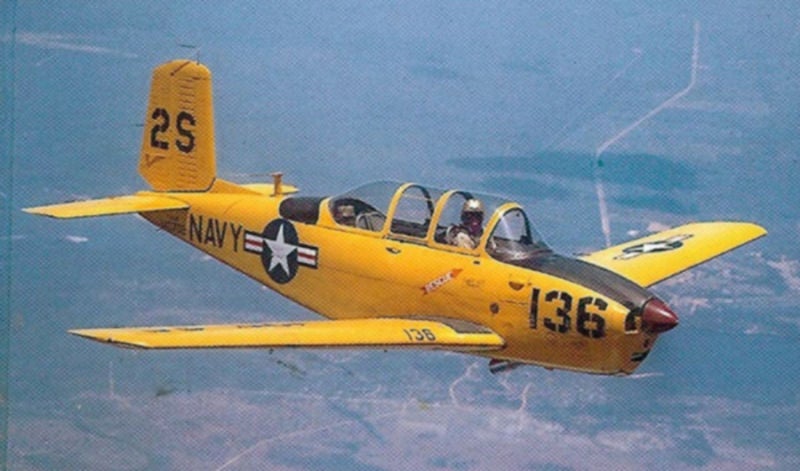
December 2, 1948 – The first flight of the Beechcraft T-34 Mentor. For many years, the North American T-6/SNJ Texan was the primary trainer for US military pilots, as well as many other air forces around the world. Over 15,000 Texans were built following its first flight in 1935, and its rugged design and and adaptability to many different missions made it a tough act to follow.
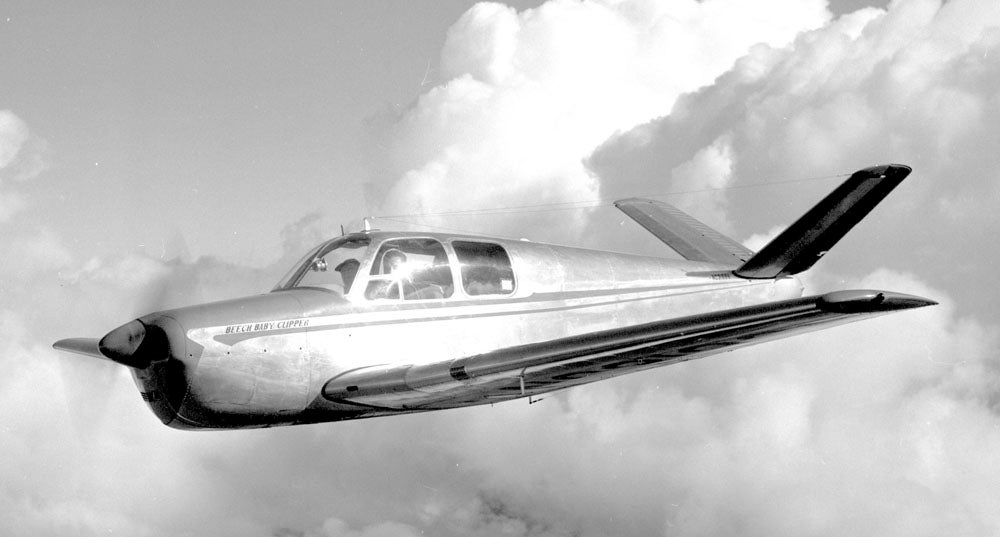
Nevertheless, Walter Beech , who had founded the Beechcraft Aircraft Company in 1932, rolled the dice following WWII and began development of what was dubbed the Beechcraft Model 45 to serve as a replacement for the venerable Texan, even though the US military had expressed no interest in a new trainer, nor did they have the budget for one. Based largely on the Beechcraft Bonanza , the Model 45 went through three design concepts, one of which employed the Bonanza’s signature V-tail, though in the end, Beech adopted a traditional tailplane to appeal to conservative military brass. The Bonanza fuselage was narrowed, and a bubble canopy was installed to allow better visibility for the tandem cockpit. The aircraft was also significantly strengthened to hold up under the rigors of military training. Power for the Mentor came from a Continental E225 flat six-cylinder engine that offered 225 hp, and production of two main variants began in 1953: the T-34A for the US Air Force, and the T-34B for the US Navy, which was optimized for carrier operations. Both versions entered service in 1953.

But with the jet engine becoming the primary powerplant for military aircraft, Beechcraft began another internal project to develop the T-34 into a jet trainer. This resulted in the Model 73 Jet Mentor, which was powered by a single Continental J69 turbojet. However, when the Navy passed on the Jet Mentor and the Air Force chose the Cessna T-37 Tweet as their jet trainer, the Jet Mentor was abandoned after construction of just a single prototype. The piston-powered T-34 remained in service, though initial production halted in 1959.
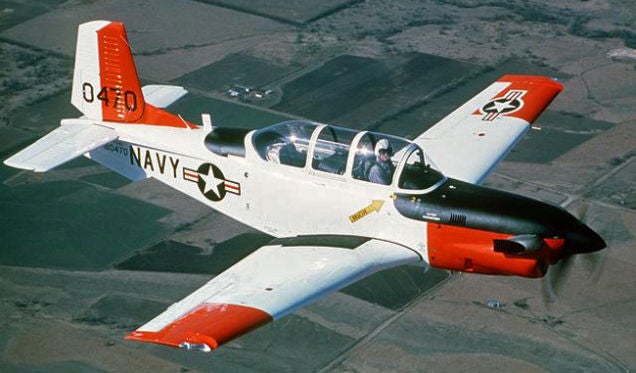
But the idea of a jet-powered Mentor never quite died, and T-34 production was restarted in 1973 at the request of the US Navy for a turboprop powered variant. This aircraft, powered by a Pratt & Whitney Canada PT6 turboprop engine, was designated the T-34C and remained in service until the 1990s, when the T-6 Texan name reappeared with the Beechcraft T-6 Texan II , a derivative of the Pilatus PC-9 . In all, more than 2,300 Mentors were built throughout the two production runs, and many remain in private hands where they are frequently seen on the air show circuit. (US Navy photos; Bonanza photo via Bill Larkins via Wikimedia Commons )
!!! UNKNOWN CONTENT TYPE !!!

December 2, 1937 – The flight of the Brewster F2A Buffalo. History remembers and lionizes the great fighters of the Second World War, aircraft such as the North American P-51 Mustang or the Supermarine Spitfire , powerful and nimble fighters that clawed enemy aircraft from the skies, helped the Allies win the war, and are still revered today for their performance and beauty. The Brewster Buffalo, however, does not hold such a place in the pantheon of great fighters, and, in the years since WWII, the Buffalo has come to be regarded as a failure, a symbol of obsolescent technology and poor design. However, that scorn is not entirely warranted.
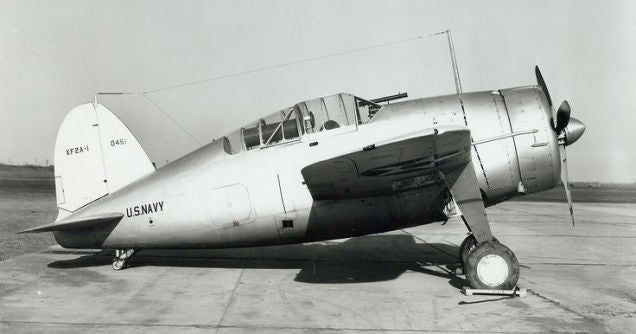
The story of the Buffalo began in 1935, when the US Navy requested a new fighter to replace the Grumman F2F biplane. They accepted three entrants into the competition for a production contract: the Buffalo, the Grumman XFF-1 , a biplane fighter with retractable landing gear which would eventually be developed into the F4F Wildcat , and a navalized version of the Seversky P-35 , which was quickly eliminated for its lack of speed.
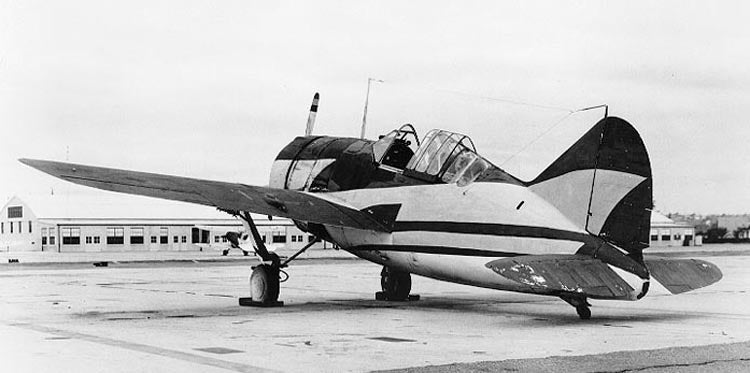
By the design standards of the 1930s, the Buffalo was a truly modern aircraft. It boasted all-metal, flush-riveted, stressed aluminum construction, split flaps , and hydraulically operated retractable landing gear. It’s Wright R-1820 Cyclone radial engine provided a stout 950 hp, and the Buffalo had an impressive climb rate for its day, though its single-stage supercharger severely limited its high altitude performance. The Buffalo also lacked self-sealing fuel tanks or armor plating to protect the pilot, features that became standard on later American fighters. Armament was provided by a single .50 caliber machine gun and a single .30 caliber machine gun, both mounted in the nose.
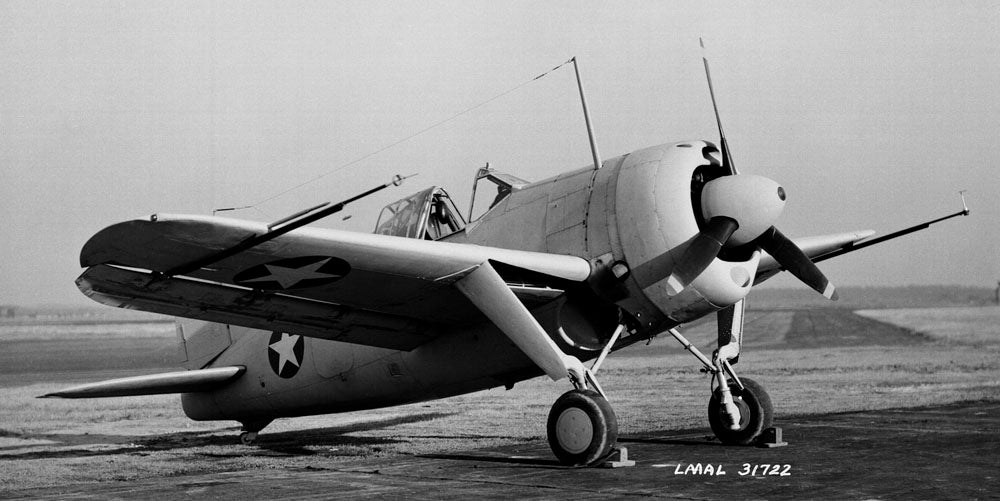
The first variant, the F2A-2, attempted to address some of the problems of the F2A by providing increased armament and a more powerful engine, but the resulting weight gain nullified any performance improvements. The final version, the F2A-3, added improved range and provision for underwing stores, but the Navy and Marine Corps had already lost confidence in the Buffalo. By 1940 it was clear that the Buffalo was completely outclassed by more nimble Japanese aircraft such as the Mitsubishi A6M and Nakajima Ki-43 , and the remaining Buffalos were retired from combat following the Battle of Midway and transferred to Navy training squadrons in the US. British experience with the Buffalo in Malaya and Burma was little better, with aircraft prone to oil leaks that fouled windscreens and speeds well under Brewster’s billing. Still, four Commonwealth pilots managed to become aces in the Buffalo early in the war.
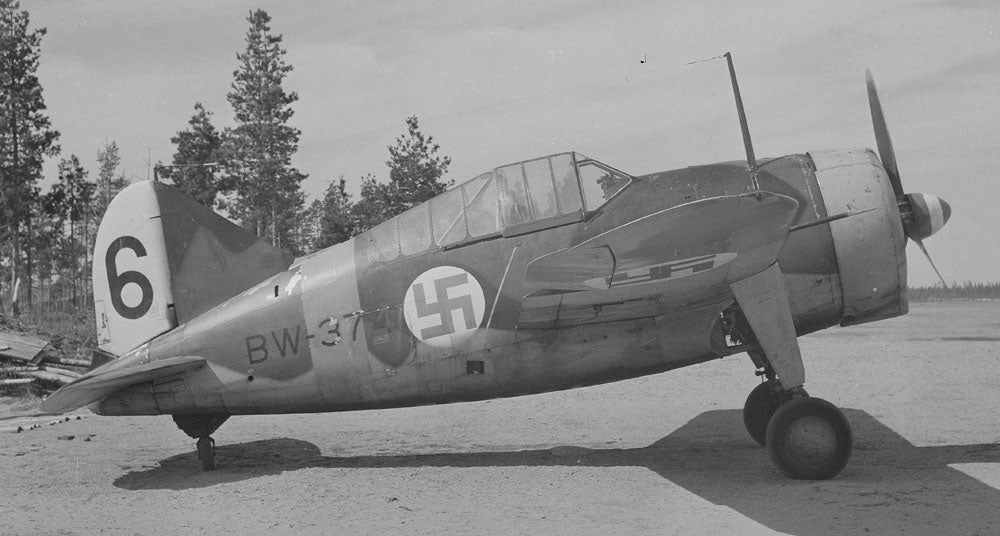
Despite the difficulties faced by American and Commonwealth pilots, the Buffalo fared much better elsewhere, particularly in the hands of Finnish pilots, who liked the Buffalo and flew it with great effect. The export model was known as the B-239, and Finland’s greatest ace, Ilmari Juutilainen , scored 34 of his eventual 94.5 kills while flying a Buffalo against Russian fighters. Cooler weather, better maintenance practices and superior tactics allowed greater success for the plucky fighter, and it served with distinction during the Continuation War . Just over 500 Buffalos were built, and they ended their service in 1948. (US Air Force photo; US Navy photos; NASA photo; Finnish Government photo)
!!! UNKNOWN CONTENT TYPE !!!
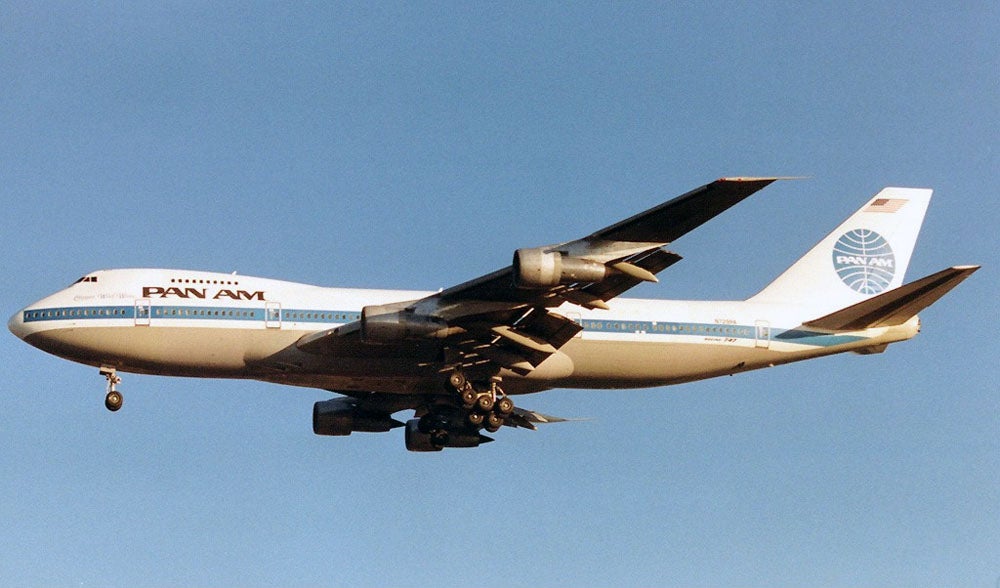
December 4, 1991 – Pan American Airways ceases operations, 63 years after its founding. Following the First World War, the aviation and airline industries grew at a rapid pace, as fledgling commercial airlines began to stretch their tendrils further and further across the globe. But as the airlines grew, their mission became as much about spreading national influence abroad than just hauling passengers and mail.
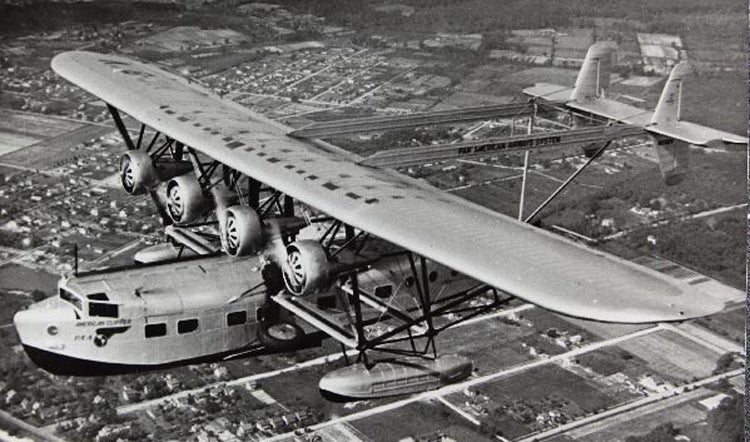
In 1919, the government of Germany joined with Columbia to form the world’s second airline, the Sociedad Colombo Alemana de Transportes Aéros (SCADTA, or Colombian-German Air Transport Partnership). SCADTA wanted to carry mail from Bogota to the US via the Panama Canal, but the United States government was none too keen on having such heavy German influence over the first airline in the Americas, which they felt could threaten the vital canal gateway between the Atlantic and Pacific Oceans. So US Army Air Corps Major Henry H. “Hap” Arnold and Major Carl Spaatz, both of whom would go on to play significant roles in the Second World War, created a shell company known as Pan American Airways on March 14, 1927. With US government support, Pan Am soon had exclusive contracts to carry mail to Central and Latin America, making sure that no other American companies would outbid them. Thus began a 63-year history of Pan Am being the practical, though not official, flag-carrier airline of the US, and its blue globe logo became as much a symbol of the United States as the US flag.
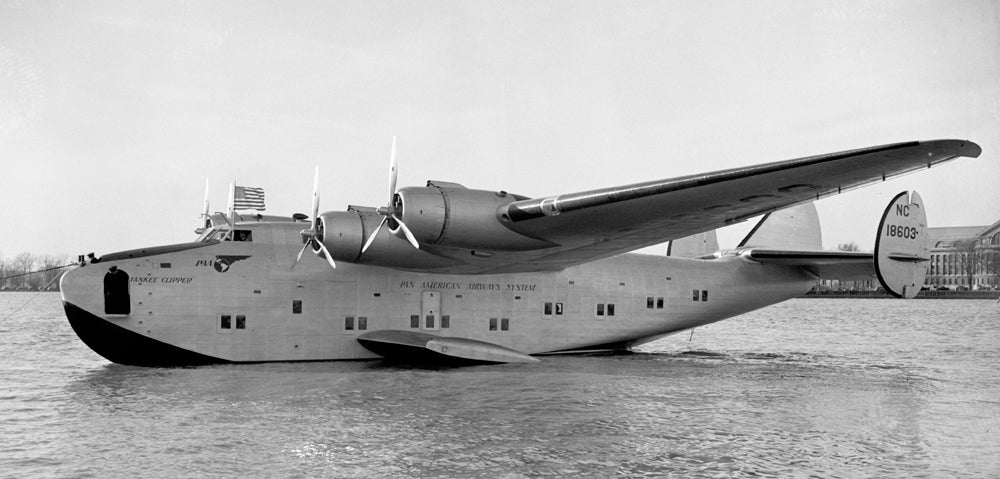
Under the leadership of Juan Trippe , Pan Am grew rapidly by aggressively buying small airlines and expanding mail and passenger routes in South America.By 1937, Pan Am was providing Sikorsky S-42 seaplane service to Europe, and had started pushing westward from the US to Hawaii and the Far East, flying the Boeing 314 Clipper , which made the world’s first transatlantic passenger flight, and the pressurized Boeing 307 Stratoliner , the first pressurized airliner to enter service. Pan Am also became the first airline to carry out a circumnavigation of the globe with paying passengers.
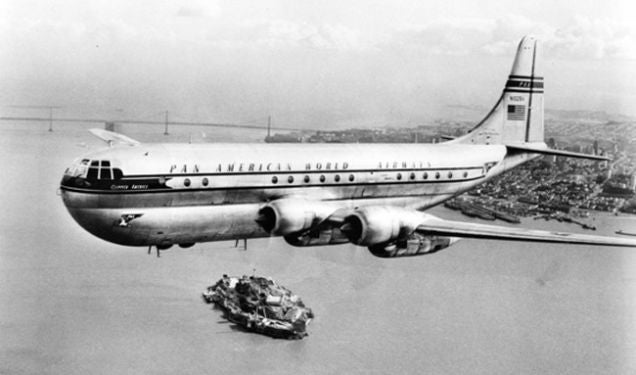
Following WWII, Pan Am undertook modernization of its fleet, and soon became an industry leader in the innovation of the airline industry. As the world entered the jet age, Pan Am served as the launch customer for both the
Boeing 707
and
Boeing 747
, inaugurating its first transatlantic jet service in 1958. Pan Am was also an industry leader in its use of computerized reservation services, teaming with IBM to develop the PANAMAC system that was housed in their iconic Manhattan office building, the largest in the world at the time. At its peak in the 1960s, Pan Am carried 6.7 million passengers and served 86 countries on every continent except Antarctica.
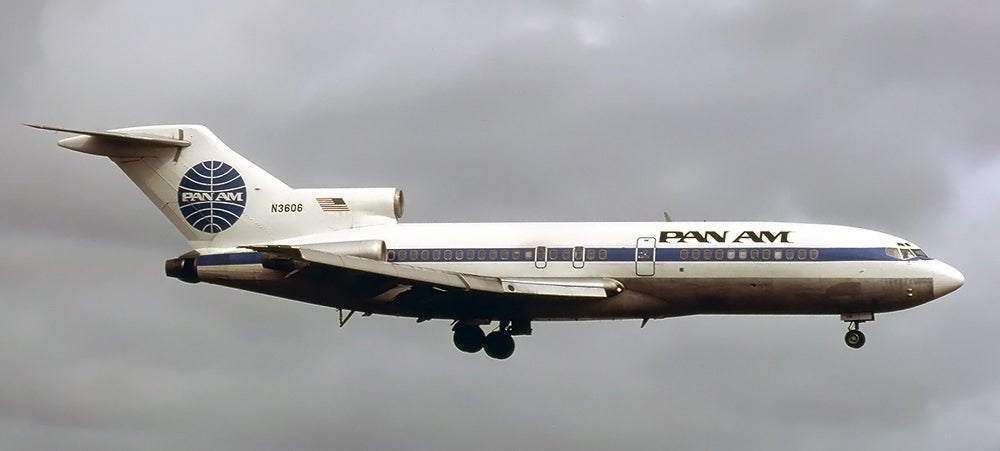
But in the 1970s, the oil crisis led to higher fuel prices and lower travel, and Pan Am found themselves in massive amounts of debt, particularly over the acquisition of new aircraft, and declared bankruptcy on January 8, 1991, becoming the third US carrier to close its doors in the face of economic hardship and competition from other airlines. After attempting to acquire domestic airlines and selling off major portions of its assets, the remainder of the company was purchased by Delta Airlines . Pan Am’s final fight was made by a Boeing 727 named Clipper 436, service from Barbados to Miami, Pan Am’s original home base. Before landing, the crew performed a fly-by down the Miami runway in tribute to history of one of America’s most storied airlines. (Photo by JetPix via Wikimedia Commons ; San Diego Air and Space Museum photo; US Library of Congress photo; San Diego Air and Space Museum photo; photo by Peter Duijnmayer via Wikimedia Commons )
!!! UNKNOWN CONTENT TYPE !!!
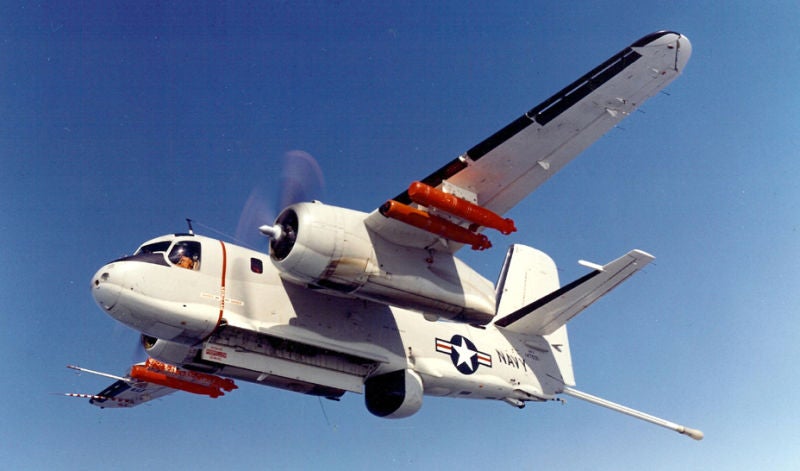
December 4, 1952 – The first flight of the Grumman S-2 Tracker. During World War I, German U-boats prowled the seas virtually undetected and wreaked havoc on both military and civilian shipping. Maritime reconnaissance aircraft patrolled the skies, hoping to catch a glimpse of submarines on the surface, but their role in anti-submarine warfare (ASW) was largely limited to forcing the subs to submerge. Developments in sonar between the wars helped surface ships detect submerged submarines during World War II, but airplanes were still relegated to a strictly reconnaissance or attack role, and were unable to detect submerged submarines on their own. It wasn’t until the development of airborne radar systems that aircraft took on the role of both finding and destroying enemy submarines, but early detection gear was too large to fit into a single aircraft that was capable of operating from US Navy carriers. The Navy’s initial solution was to split the load between two aircraft, one hunter and one killer. Grumman developed the AF Guardian system of two planes, but clearly, this was just a stopgap measure until a dedicated ASW aircraft could be developed. That aircraft was the Grumman S-2 Tracker, the first dedicated, all-in-one ASW aircraft in the US Navy.

The Tracker was a large, twin engine aircraft powered by two Wright R-1820 Cyclone radial engines mounted on a high wing, an arrangement that allowed for the most space possible inside fuselage. The rear of the large engine nacelles housed sonobuoys that were dropped into the ocean to locate submerged submarines. For tracking, the crew relied on an AN/APS-38 radar that was housed in a retractable radome, as well as a magnetic anomaly detector (MAD) boom in the tail that detects tiny variations in the Earth’s magnetic field to snoop out submerged subs. A 70-million candlepower search light was also fitted to the starboard wing. For attack, the S-2 carried two torpedoes or a single nuclear depth charge, and hard points on the wings carried rocket pods, depth chargers or four additional torpedoes.
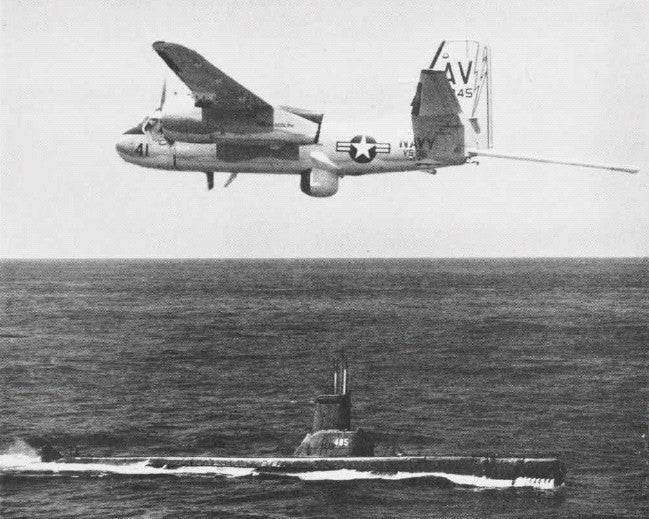
The need for the Tracker was so great, and the Navy was so sold on the design, that they ordered two prototypes and 15 production aircraft at the same time, with the first aircraft entering service in 1954. The Tracker was soon upgraded with modern electronics, and the S-2B received the Jezebel passive long-range acoustic search equipment, which worked in conjunction with Julie, an active acoustic echo ranging detection system that used explosive charges to locate underwater submarines. Further refinements brought the S-2C, which was an enlarged aircraft that could carry yet more electronic snooping hardware, and the S-2D, which had a larger wing, more fuel capacity, and more sonobuoys stored in the engine nacelles. The Tracker was widely exported to western allies, and nearly 1,300 were produced, including approximately 100 that were built under license by de Havilland in Canada, aircraft which received the designation CS2F.

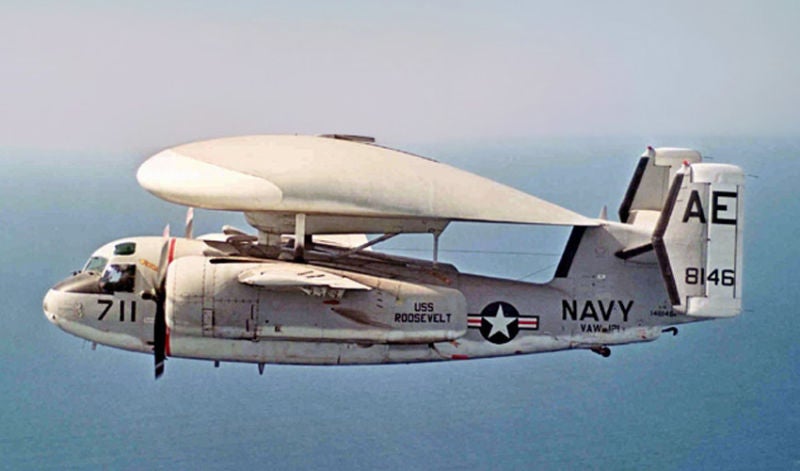
While the Tracker and its ASW equipment gear proved to be an excellent sub hunter, the aircraft itself was useful in other ways. With the electronic tracking gear removed, the large internal space could be used for cargo, and Grumman developed a variant stripped of all electronics and weapons which was called the C-1 Trader . The Trader performed the Carrier Onboard Delivery role until its replacement by the Grumman C-2 Greyhound . The Tracker was further developed into the E-1 Tracer , the first purpose-built airborne early warning radar aircraft which sported a large radome to track aircraft near the carrier battle group. But the remarkable Tracker wasn’t done yet. In the 1970s, Conair Aerial Firefighting converted surplus Trackers into the Conair Firecat , with all military equipment removed and replaced by an 870 gallon tank for dropping fire retardant. A total of 1,284 Trackers were produced, and it remains in service with the Argentine and Brazilian Navies. (Photo author unknown via Pinterest ; US Navy photos)
!!! UNKNOWN CONTENT TYPE !!!
!!! UNKNOWN CONTENT TYPE !!!
!!! UNKNOWN CONTENT TYPE !!!
!!! UNKNOWN CONTENT TYPE !!!
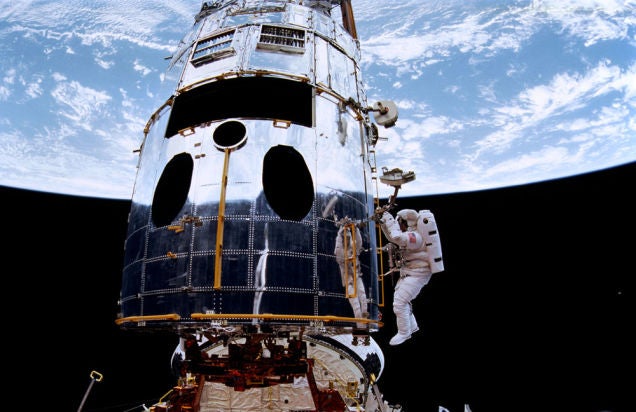
December 2, 1993 – The launch of Space Shuttle Endeavour on STS-61, the first mission to service the Hubble Space Telescope (HST). The HST was launched in 1990, but faulty optics from an incorrectly ground mirror resulted in distorted images. In one of the most complex Shuttle missions to date, seven specially trained astronauts performed five extended extra-vehicular activity (EVA) periods to replace the High Speed Photometer with the COSTAR corrective optics package, install the new Wide Field and Planetary Camera 2 , replace four gyroscopes, and upgrade the computers. The HST was then boosted to a higher orbit. NASA considered the mission a complete success when Hubble began transmitting some of the sharpest images of the cosmos ever taken. Four additional servicing missions were flown, the last in 2009. (NASA photo)
!!! UNKNOWN CONTENT TYPE !!!

December 2, 1976 – The first flight of the Shuttle Carrier Aircraft. Though NASA originally considered using the Lockheed C-5 Galaxy to transport the Space Shuttle, they instead chose to modify a Boeing 747-100 airliner for the task, since the airliner employed a low wing and the C-5 would have to remain the property of the US Air Force. The first SCA (N905NA) was acquired from American Airlines in 1974, and a second (N911NA) was acquired from Japan Airlines in 1988 as a spare after the Challenger disaster . Modifications included the addition of mounting points for the Shuttle, a strengthened fuselage, improved avionics, more powerful engines, and the addition of vertical stabilizers at the end of the horizontal stabilizers for added control when the Shuttle was mounted. The SCA participated in glide tests of the original Shuttle Enterprise (OV-101), and ferried Shuttles from landings in California back to the launch site in Florida. Both SCAs were retired in 2012 at the end of the Space Shuttle program . (NASA photo)
!!! UNKNOWN CONTENT TYPE !!!
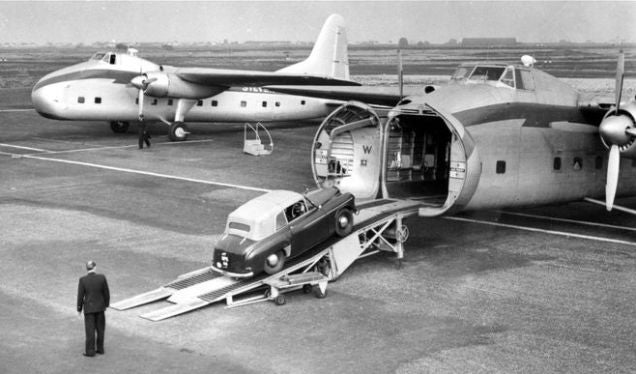
December 2, 1945 – The first flight of the Bristol Type 170 Freighter. The 170 was originally created as a measure to keep employees of the Bristol Aeroplane Company working while the huge, and ultimately unsuccessful, Bristol Brabazon was under development. Placement of the cockpit above the cargo hold helped accommodate as large a payload as possible, and clamshell doors at the front facilitated cargo loading and unloading. An all-passenger variant was developed, called the Wayfarer, as well as a car-ferrying version that allowed passengers to bring their cars along on trips to the European Continent. Bristol built 214 Freighters between 1945-1958, and they served numerous civilian and military carriers around the world. (Photo author unknown)
!!! UNKNOWN CONTENT TYPE !!!
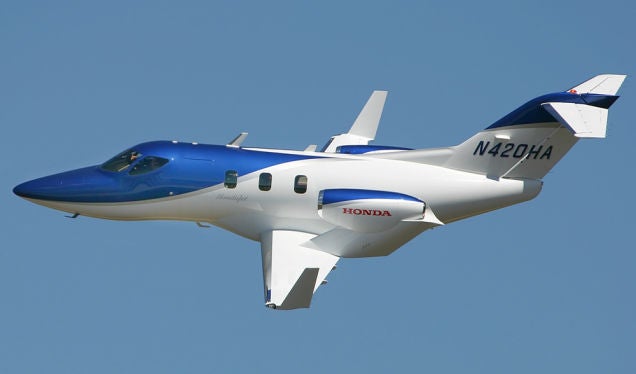
December 3, 2003 – The first flight of the Honda HA-420 HondaJet, the first aircraft developed by Honda Aircraft Company. The HondaJet was designed in Japan and will be built in the United States at Honda’s factory in Greensboro, North Carolina. The maiden flight was performed by a proof-of-concept aircraft, not a final production model, and Honda announced in 2006 that it would commercialize the new light business jet. In March 2015, the HondaJet received its Provisional Type Certification from the FAA, and the aircraft is currently under production, with the first of approximately 100 orders delivered in December 2015. (Photo by Sergey Ryabtsev via Wikimedia Commons )
!!! UNKNOWN CONTENT TYPE !!!

December 3, 1973 – Pioneer 10 returns the first close-up images of Jupiter. Pioneer 10 was launched on March 3, 1972 and reached Jupiter in November 1973. The probe eventually transmitted 500 images as it passed as close as 82,000 miles to the Solar System’s largest planet. The pictures returned by Pioneer 10 were of a higher quality than any image ever taken from Earth, and the photos were displayed back on Earth in real time in a presentation that received an Emmy Award. The photographs allowed scientists to determine that Jupiter is composed mostly of liquid, and scientists could also discern weather patterns on the planet based on observations of Jupiter’s clouds. After passing Jupiter, Pioneer 10 became the first spacecraft to achieve escape velocity from the Solar System, and, if left undisturbed, it will continue towards the star Aldebaran , more than 68 light years away, though it will require more than two million years to reach the star at its current velocity. (NASA photo)
!!! UNKNOWN CONTENT TYPE !!!
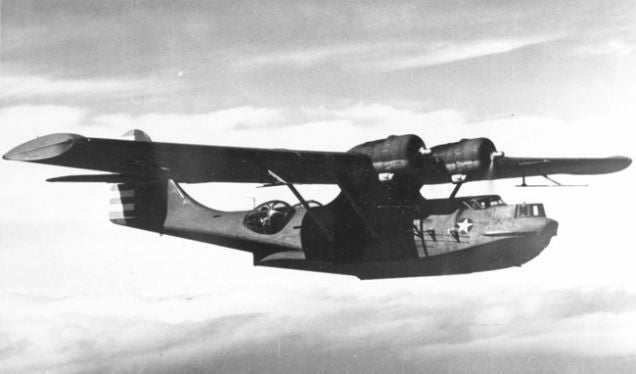
December 3, 1944 – The rescue of survivors from the destroyer USS
Cooper
(DD-695).
While on a mission to intercept Japanese supply ships near the Philippine Islands,
Cooper
was torpedoed by a Japanese destroyer and sunk with the loss of 191 crewmen. 168 were rescued, including 56 who were loaded into a single US Navy
Consolidated PBY Catalina
belonging to Patrol Bombing Sqn VPB-34 and commanded by Lt. Joe Frederick Ball. For his actions in rescuing a record number of victims, Ball received the
Navy Cross
. The
citation
reads in part:
[Ball] carried out the entire rescue with consummate skill and with total and repeated disregard for his personal safety, remaining on the water for almost an hour with many enemy planes in the vicinity, and repeatedly taxiing his plane well within point-blank range of guns on the enemy-held coastline and of two enemy warships, in his effort to pick up survivors. When his plane could hold no more, he was forced to make a run of three miles in order to get off the water.
A second PBY recovered 48 survivors
.
(US Navy photo)
!!! UNKNOWN CONTENT TYPE !!!
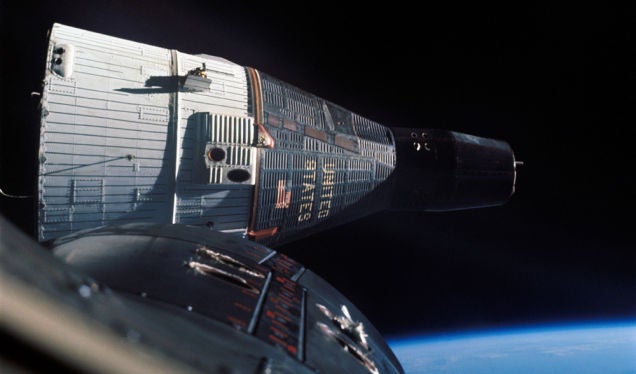
December 4, 1965 – The launch of Gemini 7, the fourth manned flight of the Gemini program and the 12th manned American space flight. Astronauts Frank Borman and Jim Lovell circled the Earth 206 times and remained in orbit for 14 days. The primary goal of the mission was to act as a passive target for a rendezvous in space with Gemini 6A , which was launched 11 days after Gemini 7. Gemini 6A astronauts Walter “Wally” Schirra and Thomas Stafford maneuvered to within one foot of Gemini 7, and could have docked had the two spacecraft been fitted with docking equipment. After the rendezvous, Borman and Lovell spent three more days in space with little more to do than read books to pass the time, and returned to Earth on December 18. (NASA photo)
!!! UNKNOWN CONTENT TYPE !!!
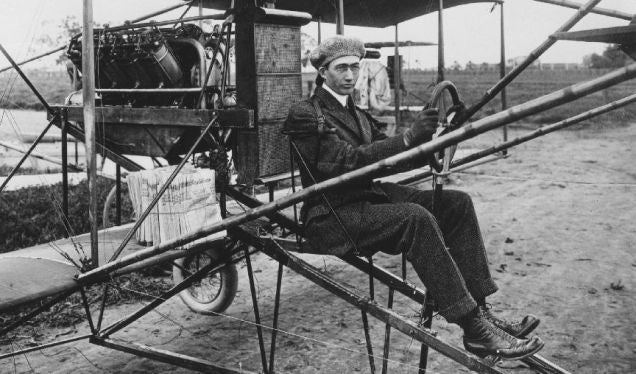
December 4, 1955 – The death of Glenn L. Martin, an early American aviation pioneer who founded his own aircraft company in 1912. Born on January 17, 1886 in Macksburg, Iowa, Martin’s first successful aircraft was the Martin MB-1 , a large biplane bomber that served in WWI. Martin went on to create many successful aircraft during WWII, notably the B-26 Marauder and Maryland bombers, as well as large flying boats such as the PBM Mariner and the JRM Mars . Following the war, the Martin Company found success in the aerospace industry, building the Vanguard rocket, the first American rocket built specifically for orbital launch, and followed the Vanguard with the Titan series of larger rockets. In 1961, a merger formed Martin-Marietta , and that company eventually merged with Lockheed to form Lockheed Martin in 1995. (Photo via San Deigo Air and Space Musem)
!!! UNKNOWN CONTENT TYPE !!!
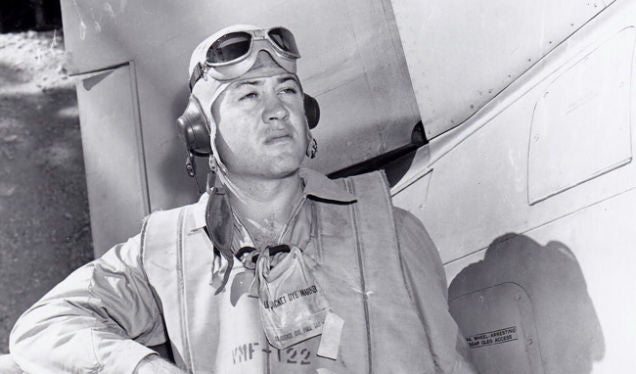
December 4, 1912 – The birth of Gregory “Pappy” Boyington. Boyington began his military flying career as an aviation cadet in the US Marine Corps Reserve before resigning his commission to fly with the American Volunteer Group , better known as the Flying Tigers, fighting for Nationalist China against the Japanese. Returning to the USMC in 1942 at the rank of major, Boyington became famous as the commander of VMF-214 , better known as the Black Sheep, a squadron flying the Vought F4U Corsair in the Pacific. In January 1944, Boyington tied the record of famed WWI ace Eddie Rickenbacker with 26 victories, but was then shot down and ended the war as a POW. Following the war, Boyington received the Navy Cross and the Congressional Medal of Honor for his service, and died in 1988 at the age of 75. (Photo author unknown)
!!! UNKNOWN CONTENT TYPE !!!
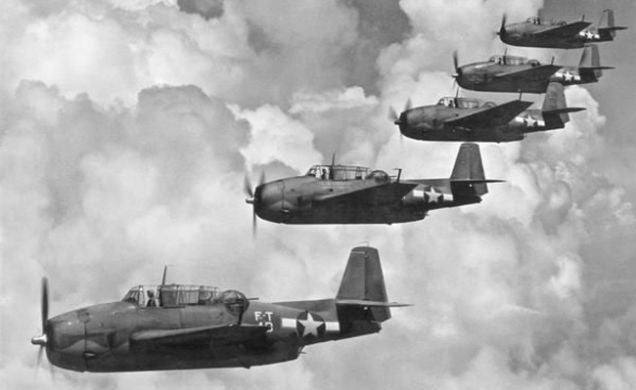
December 5, 1945 – Five Grumman TBM Avenger torpedo bombers disappear in an area known as the Bermuda Triangle. Flight 19 was a routine navigation and bombing training mission that departed from NAS Fort Lauderdale. The Avengers were scheduled to fly east, drop their bombs, fly north, then turn for home. The lead pilot reported an inoperative compass, and the planes became lost. The Navy presumes that they headed out to sea, ran out of fuel, and crashed, killing the 14 crewmen. Two Martin PBM Mariner seaplanes were sent to look for the missing Avengers , and one exploded in midair, killing the 13-man crew. The disappearance of Flight 19 has often been touted as an example of mysterious disappearances in the area of the Bermuda Triangle , and the planes have never been found. (US Navy photo)
!!! UNKNOWN CONTENT TYPE !!!
!!! UNKNOWN CONTENT TYPE !!!
!!! UNKNOWN CONTENT TYPE !!!
!!! UNKNOWN CONTENT TYPE !!!
!!! UNKNOWN CONTENT TYPE !!!
!!! UNKNOWN CONTENT TYPE !!!
!!! UNKNOWN CONTENT TYPE !!!
If you enjoy these Aviation History posts, please let me know in the comments. And if you missed any of the past articles, you can find them all at
Planelopnik History
. You can also find more stories about aviation, aviators and airplane oddities at
Wingspan
.
!!! UNKNOWN CONTENT TYPE !!!
 "For Sweden" (rallybeetle)
"For Sweden" (rallybeetle)
12/05/2017 at 12:40, STARS: 3
Legend Says that some of the first designers of the HondaJet lived to see its first flight.

12/05/2017 at 13:01, STARS: 0
if left undisturbed, it will continue towards the star Aldebaran , more than 68 light years away, though it will require more than two million years to reach the star at its current velocity.
Yeah, if...
!!! UNKNOWN CONTENT TYPE !!!
John Conroy, designer of the Guppy series of outsize aerial cargo planes, proposed a pair of B-52s under a new wing as an entry for the SCA
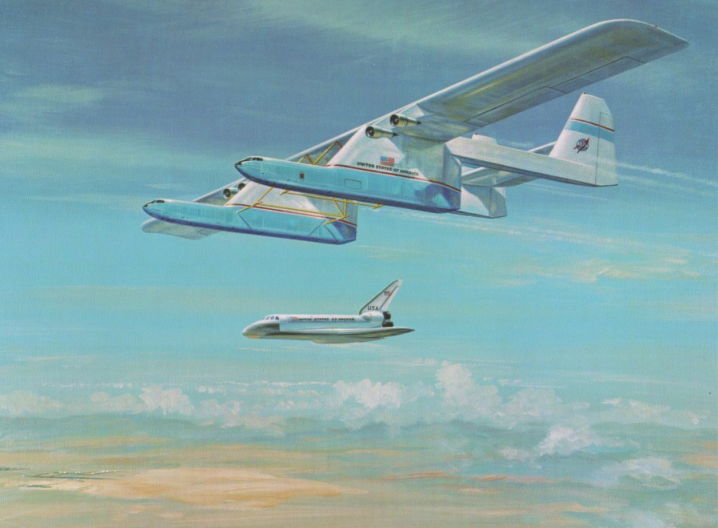
Then of course Lockheed had to one-up with a twin C-5:
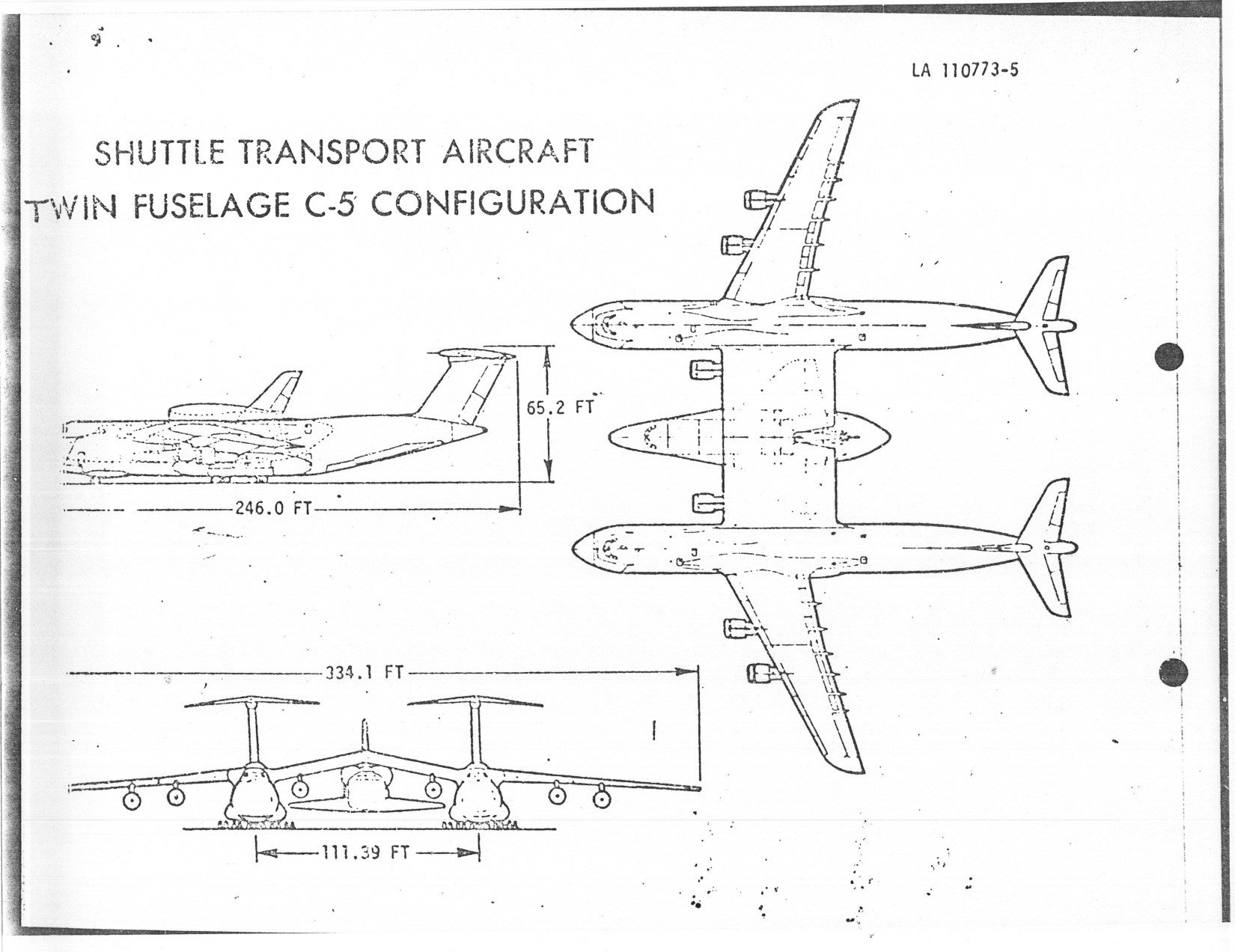
NASA tested a scale model of the Conroy Virtus before rejecting it, while the Twin C-5 never made it past the sketch above.
 "ttyymmnn" (ttyymmnn)
"ttyymmnn" (ttyymmnn)
12/05/2017 at 13:06, STARS: 3
And then there’s Paul Allen.
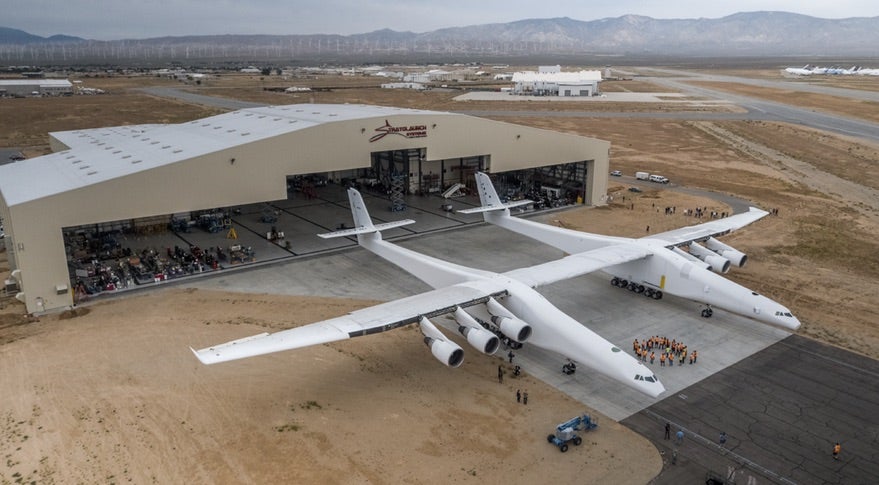
 "WilliamsSW" (williamssw)
"WilliamsSW" (williamssw)
12/05/2017 at 13:16, STARS: 1
I know you and Ramblin Rover have talked about what it would take to build an airworthy Mosquito, but the one lost aircraft that I’d most like to see flying again is the Boeing 314. Not gonna happen, but still...
And remember this show? https://en.wikipedia.org/wiki/Baa_Baa_Black_Sheep_(TV_series)
 "ttyymmnn" (ttyymmnn)
"ttyymmnn" (ttyymmnn)
12/05/2017 at 13:21, STARS: 2
My brother and I watched just about every episode of that show back in the day. It never occurred to me at the time that New Guinea looked an awful lot like Southern California. That show kindled a fascination for the F4U that exists to this day. It also coincided with the age at which I first started to become interested in military and aviation history.
 "Smallbear wants a modern Syclone, local Maple Leafs spammer" (smallbear94)
"Smallbear wants a modern Syclone, local Maple Leafs spammer" (smallbear94)
12/05/2017 at 13:27, STARS: 0
Re the formation of Pan Am, it was actually a merger of 3 competing companies that at the time were little more than paper.
Arnold’s company was the one that was worried about the German line. As a result they bid low to get the contract and secure the contract, hoping to eventually put SCADTA under. They had no aircraft, no money and no landing rights in Cuba.
The second company I forget the owners of, but they had access to the necessary money.
The third company, run by Trippe, held the trump card. Months before, Trippe had gone to see the Cuban President, who had agreed to give Trippe exclusive landing rights in Cuba.
Money and aircraft could be found elsewhere, but the landing rights were one of a kind. With a deadline on the start of service and Trippe refusing to budge—as usual—they had no choice but to merge and let Trippe take charge.
Also, re SCADTA—Arnold’s purpose was eventually fulfilled, as several years later (can’t remember exact dates) PanAm bought a controlling interest of the line. The sale was kept secret for political reasons and remained under the control of the Germans at the time, but it was effectively under the command of PanAm.
 "WilliamsSW" (williamssw)
"WilliamsSW" (williamssw)
12/05/2017 at 13:32, STARS: 1
We only had 1 TV back then for the 4 of us, and my parents weren’t interested in it, so I rarely got to watch it, but I tried.
 "ttyymmnn" (ttyymmnn)
"ttyymmnn" (ttyymmnn)
12/05/2017 at 13:40, STARS: 0
My brother and I were usually relegated to the 13" TV in the kitchen.
 "ttyymmnn" (ttyymmnn)
"ttyymmnn" (ttyymmnn)
12/05/2017 at 13:41, STARS: 2
Thanks for the additional info. Condensing so much information can be a challenge, and I am often guilty of oversimplifying in the interest of space. I’m sure there is a Pan Am timeline out there somewhere. That would have been helpful.
 "Jetstreamer" (jetstreamer)
"Jetstreamer" (jetstreamer)
12/05/2017 at 13:48, STARS: 4
Relevant...
!!! UNKNOWN CONTENT TYPE !!!
 "Smallbear wants a modern Syclone, local Maple Leafs spammer" (smallbear94)
"Smallbear wants a modern Syclone, local Maple Leafs spammer" (smallbear94)
12/05/2017 at 13:48, STARS: 1
Yeah, I get it. The only reason my comment is as short as it is is because I forgot a lot of the details. And it’s still not really short...
Still, I’ll try to fill in where I can. :) Your stuff has been mostly new info for me lately.
 "ttyymmnn" (ttyymmnn)
"ttyymmnn" (ttyymmnn)
12/05/2017 at 13:56, STARS: 1
Your stuff has been mostly new info for me lately.
That’s good to know, since I am working on two years of these posts and it’s starting to be re-re-working of original material. As I rewrite, though, I’m taking the opportunity to tighten up the prose, add more photos, or provide updated information. I’m getting into January, though, when I took a six-week hiatus from writing to focus on an audition. So I’ve got a bit more work to do than normal. It’s fun revisiting the older material, though. I also have the time to add some things that I skipped the first time around.
 "ttyymmnn" (ttyymmnn)
"ttyymmnn" (ttyymmnn)
12/05/2017 at 13:57, STARS: 2
V-TEC kicked in, yo. That’s awesome.

12/05/2017 at 15:02, STARS: 0
They still beat Moller into the air; that counts for something, right?
 " The Compromiser" (charger)
" The Compromiser" (charger)
12/05/2017 at 18:19, STARS: 0
Two days shy of my favourite aeronautical event...
 "ttyymmnn" (ttyymmnn)
"ttyymmnn" (ttyymmnn)
12/05/2017 at 20:23, STARS: 0
Pearl Harbor?
 " The Compromiser" (charger)
" The Compromiser" (charger)
12/05/2017 at 22:39, STARS: 0
That would be the one. Not a nice one per say, but still an event.
 "ttyymmnn" (ttyymmnn)
"ttyymmnn" (ttyymmnn)
12/05/2017 at 23:06, STARS: 1
Not a nice one, but certainly an important one. I’ve got a big write up about that coming on Thursday. Go figure, right?
 "gmporschenut also a fan of hondas" (gmporschenut)
"gmporschenut also a fan of hondas" (gmporschenut)
12/05/2017 at 23:44, STARS: 0
the 30s were such a random assortment of designs,. its alsways amazing how they went from stringbags to monocoque Al, being obsolete by the time the first production runs were made.
 " The Compromiser" (charger)
" The Compromiser" (charger)
12/06/2017 at 08:04, STARS: 1
Right up there with DB Cooper, Hiroshima, Nagasaki, Dresden, 9/11, and the shoe bomber!
And as always I look forward to your write up! It’s a good day when I see a “This Date” headline. its like seeing the Goodyear Blimp with “ The Compromiser’s A Pimp” on the side of it.
 "ttyymmnn" (ttyymmnn)
"ttyymmnn" (ttyymmnn)
12/06/2017 at 11:18, STARS: 1
Thanks! I think I’m entering my third year of doing these posts, and I’m using the opportunity to rewrite, update, add more photos, and generally flesh the posts out. It’s a labor of love, so it’s nice to know people are reading.